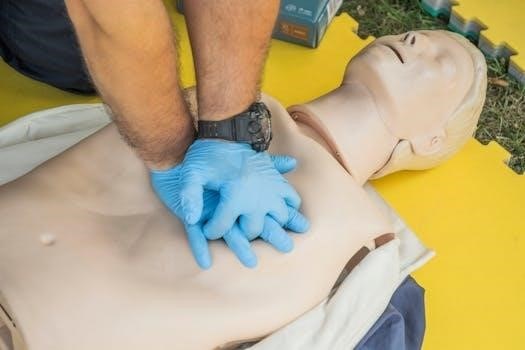First Aid/CPR/AED Participants Manual Overview
This manual supports American Red Cross courses, teaching skills for immediate care to injured or ill individuals, determining the need for advanced medical attention. It helps participants make appropriate first aid decisions. The manual emphasizes acting quickly during emergencies.
Purpose of the Manual
The primary purpose of this manual is to equip individuals with the necessary knowledge and skills to provide immediate care during emergencies. It serves as a comprehensive guide for participants in American Red Cross First Aid/CPR/AED programs. This manual empowers individuals to recognize, assess, and prioritize first aid needs effectively. It emphasizes the crucial role of immediate action in preserving life, alleviating suffering, and preventing further injury or illness. Additionally, it aims to educate participants on when and how to seek advanced medical care. The manual’s content is designed to promote confidence and preparedness in responding to various emergency situations, whether at home, in the workplace, or within the community. Ultimately, this resource intends to foster a safer and more responsive environment by empowering individuals to act decisively during critical moments. This manual is designed to make learning easy and to make it easier to apply life-saving skills.
Target Audience
This First Aid/CPR/AED Participants Manual is primarily intended for individuals participating in American Red Cross First Aid/CPR/AED training courses. The manual caters to a diverse audience, including community members, workplace personnel, and anyone seeking to learn essential emergency response skills. It is designed to be accessible and understandable for individuals with varying levels of prior medical knowledge or training. The manual also serves as a helpful reference guide for instructors and those seeking to refresh their skills. It provides a structured learning approach, which can be used by both first-time learners and those who need a review. The content is tailored to ensure that all participants can grasp the information and confidently apply the learned techniques. This manual is a resource for anyone who wants to be prepared to act during a medical emergency, whether at home or in the workplace. The content is suitable for both novice and experienced users.

Manual Structure and Content
The First Aid/CPR/AED Participants Manual is structured to facilitate effective learning and skill acquisition. It typically begins with an overview of first aid principles and the importance of acting quickly in emergencies. The manual then progresses to detailed instructions on recognizing and assessing emergencies, prioritizing needs, and providing immediate care; It contains comprehensive sections on performing CPR on adults, children, and infants, as well as how to use an Automated External Defibrillator (AED). The content is often presented through a combination of text, illustrations, and diagrams to enhance understanding. Furthermore, the manual includes chapters on environmental emergencies, injury prevention, and legal considerations. It serves as a comprehensive guide to prepare participants for a wide variety of emergency situations. The manual ensures a structured learning experience, progressing from basic concepts to more advanced procedures in a logical manner. Practical scenarios are often included to help participants apply their newly acquired knowledge.

Key Components of First Aid
Key components involve recognizing emergencies, assessing situations quickly, prioritizing immediate needs, and providing appropriate care. These steps are essential to preserve life, prevent further harm, and promote recovery until help arrives.
Recognizing and Assessing Emergencies
Recognizing an emergency is the crucial first step in providing aid. This involves quickly identifying situations that require immediate attention, such as sudden illness, injury, or trauma. Assessing the scene for safety is paramount before approaching the victim. Look for hazards that could pose a risk to you or the injured individual. This might include traffic, fire, or unstable structures. Once the scene is deemed safe, you should assess the victim’s condition by checking for responsiveness, breathing, and pulse. Gather information about the incident to understand the nature of the emergency. This may involve asking witnesses, if possible, what happened. The ability to recognize and accurately assess an emergency is a cornerstone skill.
Prioritizing First Aid Needs
Once an emergency is recognized and assessed, prioritizing first aid needs becomes essential. This involves determining the most critical conditions that require immediate attention. Life-threatening issues, such as lack of breathing, severe bleeding, or unconsciousness, always take precedence. After addressing the most urgent problems, you can then focus on other injuries or illnesses. A systematic approach helps to ensure that no critical needs are overlooked. This often involves using a “primary survey” to identify and address critical issues first. The goal is to provide the most effective care based on the severity of the situation. Proper prioritization is vital for maximizing the chances of a positive outcome for the injured or ill individual.
Providing Immediate Care
Providing immediate care involves taking prompt action based on the assessment and prioritization of first aid needs. This includes actions like controlling bleeding with direct pressure, supporting breathing by opening the airway, and administering CPR if necessary. It also involves positioning the injured individual to prevent further harm and ensuring their comfort. Using available resources, like first aid kits, and following instructions from the manual are crucial. The immediate care provided aims to stabilize the person’s condition until professional medical help arrives. It is vital to remain calm and confident while delivering care, remembering the skills and knowledge learned during training. The ability to act quickly and effectively can make a significant difference.

CPR and AED Procedures
This section covers cardiopulmonary resuscitation (CPR) techniques for adults, children, and infants. It also details how to use an automated external defibrillator (AED). Integrating CPR and AED use is a critical part of emergency response.
Performing CPR on Adults, Children, and Infants
This section provides detailed instructions on performing CPR on individuals of different age groups. For adults, the focus is on chest compressions and rescue breaths, ensuring proper hand placement and depth. When performing CPR on children, adjustments are made to compression depth and breathing techniques to accommodate their smaller size. Infant CPR requires even more delicate techniques, utilizing two fingers for chest compressions and gentle breaths. Each age group has unique considerations, and this manual will guide you through the proper steps for administering CPR effectively. The manual emphasizes the importance of early intervention and the correct techniques for maximizing the chances of survival in all these cases. The differences in approach are clearly outlined.
Using an Automated External Defibrillator (AED)
This part of the manual provides comprehensive guidance on using an Automated External Defibrillator (AED). It emphasizes the importance of understanding AED operation in conjunction with CPR. Clear instructions are provided for how to power on the device and how to attach the electrode pads correctly. The manual covers what steps to take based on the AED’s voice prompts, how to ensure the safety of the environment before administering a shock, and what to do after delivering the shock. This section highlights how an AED analyzes heart rhythms and determines if a shock is needed, which requires understanding. The importance of quickly resuming CPR after an AED shock is also stressed here. It gives information about using an AED safely and effectively.
Integrating CPR and AED Use
This section of the manual focuses on the seamless integration of Cardiopulmonary Resuscitation (CPR) and Automated External Defibrillator (AED) use. It explains how these two life-saving techniques work together to maximize a person’s chances of survival during cardiac arrest. The manual clarifies the need for immediate CPR while simultaneously preparing the AED for use. It stresses the importance of uninterrupted chest compressions. It provides guidance on how to transition smoothly between CPR and AED operation by using AED voice prompts. It covers what to do after the AED delivers a shock. The manual emphasizes the importance of not delaying chest compressions while setting up an AED. It includes information about continuing CPR until help arrives and when to use an AED.

Additional Resources and Information
This section provides further details about managing environmental emergencies, injury prevention, and relevant legal aspects of first aid. It also includes external links and resources for more in-depth information on the topics.
Environmental Emergencies
This section addresses various environmental emergencies, providing guidance on how to respond effectively. It covers heat-related illnesses such as heatstroke and heat exhaustion, explaining their symptoms and immediate care steps. It also details cold-related emergencies like hypothermia and frostbite, outlining preventive measures and first aid actions. Additionally, the section explores bites and stings from insects, spiders, and other animals, including how to manage allergic reactions and administer epinephrine when necessary. Furthermore, it includes information on avoiding contact with poisonous plants and staying safe during lightning storms. The section emphasizes the importance of recognizing signs and symptoms and taking appropriate steps to protect individuals from environmental hazards, promoting safety in diverse situations. The information is based on the knowledge from American Red Cross.
Preventing Injuries and Illnesses
This section focuses on proactive measures to prevent injuries and illnesses. It stresses the importance of recognizing potential hazards in various environments, including workplaces, homes, and recreational settings. The content emphasizes the need for a safe environment to avoid accidents. It offers guidelines for creating safety protocols and reducing risks. This section provides practical strategies for preventing common injuries like falls, burns, and sprains. It also addresses how to minimize the spread of illnesses by promoting good hygiene practices. The information encourages the use of personal protective equipment and safe work practices. It also highlights the significance of proactive health management through proper nutrition and hydration. By adopting preventative measures, individuals can greatly reduce their risk of injury and illness, and this can be found in the American Red Cross manuals.
Legal Aspects of First Aid
This section outlines the legal considerations associated with providing first aid. It emphasizes the importance of understanding Good Samaritan laws, which offer legal protection to individuals who voluntarily provide assistance during an emergency. The content clarifies the concept of ‘duty to act,’ highlighting the situations where legal obligations exist to provide first aid. This part discusses the significance of obtaining consent before administering care, explaining implied consent in emergency scenarios. It also covers the legal implications of breaching confidentiality, emphasizing the need to protect the privacy of the individuals being helped. The information provided ensures that participants understand their legal rights and responsibilities. It also encourages first aid providers to act confidently within the boundaries of the law, while focusing on the well-being of the individuals in need. The section promotes ethical and legally sound first aid practices based on the American Red Cross manuals.
